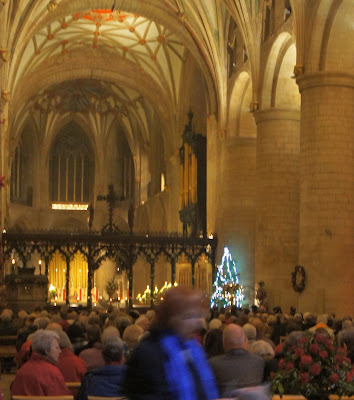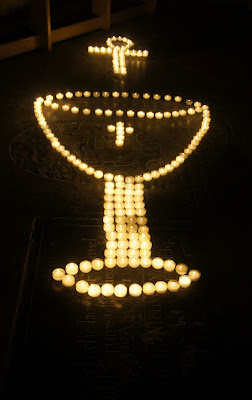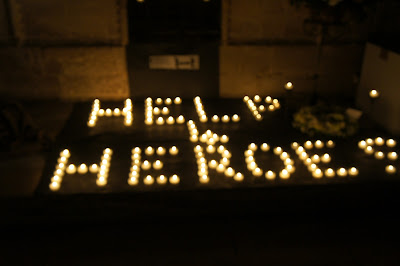http://www.thetemplebooklet.co.uk/Bobs%20Garway.htm
I am just putting forward my own photos here and giving basic information about the site, which is absolutely fascinating if you are a Templar fan.
Bruce Coplestone-Crow has suggested, not unreasonably, that the name mutated into Lagademar* ("Lagad-emar"), which is is recorded in the Domesday book as in Archenfield, TRE* (that is, tempora regis Eduardis - in the time of Edward the Confessor). Lagademar is then annotated "Garwi" in the "Herefordshire Domesday" book* (a 1160's copy of the Domesday with annotations and updates: Info), indicating they are the same location or one is in the other.
As secondary evidence* the Domesday Book notes the current holder of the land as Herman* (de Dreux*). In 1189, Richard I entitled to the 'Knights Templar' the area of Langarewi (i.e. Llan Garewi; Llan Garway) including with it castellario quod frit Hermanii*. Coplestone-Crow has suggested the castle was at Welsh Newton, where Pembridge Castle stood - this would (apparently) have been within the manor of Garway* (Castlefield Farm, just south of Garway Hill, stretches towards Grosmont Castle on the first Ordnance Survey maps, while the castle north at Orcop isn't mentioned in the Domesday book and is therefore thought to be later - neither are therefore likely to be associated with Herman's castle).

White has suggested the name "Garway" alternatively derives from Gaergwy ("fort above the river")*, while Mathews* suggests it may also derive from a discription of the river Garron as garw wy "the rough stream(?)". This seems to suggest an early British 'llan' and there is even there is another Welsh name for Garway of Llanwrfwy*. ( from an earlier spelling ((G)uorvei.
 The original church was in wood or mud and wattles and situated above the present Church.
The original church was in wood or mud and wattles and situated above the present Church.LOCATION
St. Michaels Church via the M.5 motorway. Leave the M.5 at junction 8 and move on to the M50, up to Ross-on-Wye. At the end of the M.50, travel a short distance on the A.40 to Bridstow and then turn on to the A.49. In about four miles turn left on to the B.4521. Travel along this for about eight miles, crossing the A.4137 (Whitchurch) and the A.465 (Monmouth) roads. In the Broad Oak make a right turn for the village of Garway.
The church is at the far end of the village, down a hill and turn left down the little road at the bottom - the church is signposted. The church can be seen on the left and Church Farm with its Templar dovecote is just beyond it.
The church was one of only be seen in six Templar churches in the whole of England and Wales (previously Welsh Marches) The church tower was used as a Keep or a refuge and only joined to the church in the fifteenth century.
The former Templar Preceptory, once located on what is now Church Farm, was of strategic importance overlooking the Monnow valley and the Welsh border and the headquarters of all the Templar Commanderies
Newport /Pencarn (on coastal road from Newport to Cardiff)
Llanmadoc
Kemys Commander and the Pembridge Castle Bridge
Bonvillston
Connection with ST DYFRIG/DUBRICIUS This was an early foundation of the Saint.The land
was granted by the King to St. Dyfrig in the sixth century with 108 acres for the church.
In the 1180s, The Knights Templar were granted all the land in Llangarewi by Henry II and this was confirmed to the Knights in 1199 by King John. They used the land to pay for the upkeep of the Templar organisation and for corridies for old, disabled and wounded Templars. As monk-warriors, many had no families to return to, and wished to remain within the order.
Jaques de Molay, Grand Master of the British Templars.later was horribly martyred by the ironically named French King, Philip the Fair, visited Garway in 1294. The lands of Garway are now called Church Farm.Parts of the Preceptory could still be seen in 1844 but that stone was used to build the farm.
Philip the 'Fair' greedy and evil king of France
Philip the Fair's greed and false assertations of Templar 'abuses' led to his imprisonment and horrible killling of the movement. this was entirely a political affair. The Pope's investigation ground slowly and eventually turned up a few cases of abuse, but 'pushed' nby Philip the Fair, the Pope decided to shut down the order and give the Templar assets to the Hospitallers.Most countries, turned a blind eye to Templars themselves and many kings had their eyes on the Templar gold themselves and the Hopitallers had a job to succeed to their lands, and I believe there were court cases to retrieve lands from greedy landowners, wealth being the main motive behind their compliance with the Templar supression. However, there is one entry in the Prisoners of the Tower of London, which indicate that most escaped with their lives.The Hospitallers also wrangled with the government around 1308 as they argued they were outside the tax system like the Templars.They have kept three successive Bishops of Hereford out of Garway out of Garway Church,
because he desired to tax them.
The entry in the list of prisoners of the Tower was as follows:
1307 KNIGHTS TEMPLAR Robbery, murder and "shocking habits". Order dissolved. Goods assigned to Knights of St John of Jerusalem. All members sent to other monasteries. List of Prisoners of the Tower of London.
Knights Hospitallers
The Hospitallers changed the circular nave to a rectangular shape sometime in the 15th century. The guidebook tells us that the circular nave could have become unstable due to landslip or subsidence. Also worth lookin at is the very fine Chancel roof which the Hospitallers built around 1400, which the guidebook says is one of the finest examples of the Herefordshire style of medieval roofing. The Hospitallers owned the Manor of Garway including the church until the dissolution of the monasteries in around 1540.

A Loyal Catholic Village in Penal times 1536-ca 1830
Following the dissolution of the monasteries, St Michael's became a simple village Church, which it has remained to this day. However the period of 200 years after the dissolution of the monasteries was a time of religious turmoil in Garway because most villagers remained Roman Catholic and, as a consequence, they were continually fined and their property confiscated. So a place to visit for pilgrimage in thanksgiving.
You can still see many Templar Carvvings and signs around the Church, a fine Norman arch and fine templar coffin lids used as steps etc in the Church.
The Churrch contains 17th century Pews (after the Reformation) It underwent a Victorian restoration in 1836, and it probably literally stopped the church from going into ruin.
The Holy Well is situated at the church wall and in the past year alone there has been: a historical pageant about the history of Garway and Archenfield, a May Day celebration, and a 'well-dressing' and at the reopening of an ancient holy well.
Evelyn Lord in her excellent book about the Templars in Britain wites that some of the marks in the south 
chapel, representing the holy chalice, a holy wafer, a fish and a serpent, might be from the earlier church at Llangerwy, might have been from an earlier church on the premises. These are often considered part of the Templars' 'mystic rituals' but may not be of their time. The Circular Keep or tower of the church was also apparently, apart from a store house and place of defence, a place where people could be incarcerated, in other words a prison. Evelyn Lord refers to the Reverend E.F.Powys in a lecture to the Cambrian Archeological Association also suggested that the windows in the east and west windows of the church were so high , in order that people ccooould not look in on the 'secret rites' of the templars. He claimed that a prredecessor had found an old chestt under the floor of the chancel that had contained deeds and other documents belonging to the order, which had long since 'disappeared'. It seems in 1308, the year it was turned over to the Hospitallers, Garway had a manor, a water mill and a chapel, which may have been the south chapel in the church. There were 200 acres in desmesne in open fields.Evelyn Lord tells us there was a baker and a cook and other servants, in addition to three elderly corrodians who had donated their money and lands to the order in exchange for being looked after in old age. Evelyn Lord also says that it was perhaps the closeness to Wales (formerly of course was Wales) that the Templars at Garway were younger than everywhere else when they were arrested in 1308. Philip de Mewes (preceptor) had been in the Order only five years and William de Pocklington for three!
 Perhaps the fact the order contained knightly class people from the country is also shown in the fact there were no Welsh names in the Templars arrested in 1308.
Perhaps the fact the order contained knightly class people from the country is also shown in the fact there were no Welsh names in the Templars arrested in 1308.Sanctuary
Garway, like the church at Llanthony Abbey, had the right of Sanctuary as can be seen in the picture above left. Poaching and other crimes carried the sentence of death from civil authorities, but if a criminal (and remember the crimes were often quite slight, like poaching) entered such a church clung to the altar and called for sanctuary , he had forty days to consider his options. After that, he had to give himself up or abjure the realm, be escorted to a port and take passage on a ship, or could be killed on sight. trials by ordeal were civil practices and officially not allowed by the church, but this was often ignored, as the very livelihoods of many places relied on the co-operation of such civil authorities.
Jerusalem the Centre of the Order
We learn that the Welsh Templar properties lay at the end of a chain of authority which started in Jerusalem and was overseen from provincial government and Garway was the last management post. When the Hospitallers took it over, they immediately let out the lands , realising that the Welsh estates were difficult to manage. Evelyn Lord says there is evidence in Aragon, that the Templar land in Bonvillston, Glamorgan that this villiage and Templeton were to be leased into the Lordship of Narberth but points out that they always received the same rents and were not able to capitalise when food prices were high.
More pictures from Garway NEXT!!

Another trace of Templar Connections can be found in the font at Llanrothal. Was the local Lord of the Manor a Templar, or did the Templars donate the font to the Church. Llanrothal is near Monmouth.
Here is a link to my blog on Llanrothal
http://maryinmonmouth.blogspot.com/2010/01/dreamy-llanrothal-templar-connections.html














































































































































